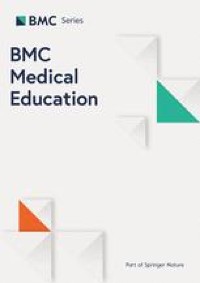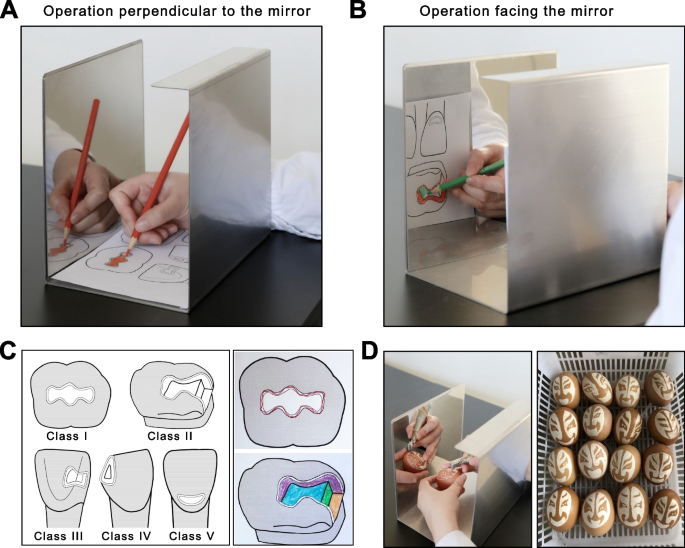Participants
A total of 72 dental students in Nanjing Medical University were selected as study subjects, including 30 males and 42 females. All students were in their second year and had no previous dental training. Detailed written informed consent was obtained from all subjects in accordance with protocols approved by the Independent Ethics Committee of the University (permit no: PJ2019-039–001).
Study design
Seventy-two dental students were randomly divided into two groups: the Control group (Ctrl group, n = 36) and the Experimental group (Exp group, n = 36). Both groups were subjected to SIMODONT system training (SIMODONT, Japan) and the 1st mirror operation examination was then performed. Afterwards, students were given dentognathic models with complete dentitions and a dental mirror in the Ctrl group. These students were asked to observe a dentognathic model using indirect vision through a dental mirror. In the Exp group, students were given mirror training using Mirrosistant (details showing below). Next, the 2nd mirror operation examination was conducted in both groups. Furthermore, mirror training using Mirrosistant was also given to the Ctrl group to ensure educational equity. Finally, all students were required to complete a subjective questionnaire about the feedbacks on mirror training using Mirrosistant (Fig. 1A).
SIMODONT system training
Because none of the participants had any experience using SIMODONT system, pre-training was conducted for every participant. Training for the SIMODONT system consisted of basic functions, handpiece grip, dental mirror, fulcrum position, operation procedures, scoring system, and related theories of the use of indirect vision. Each dental student was required to practice for 30 min using direct vision with the SIMODONT system.
Mirror operation examination
For mirror operation examination, the following task was required to be accomplished within 10 min using SIMODONT system. Each student was asked to prepare a specified rectangle hole with rounded corners by a high-speed handpiece using indirect vision through a dental mirror. This specified rectangle hole was on the back of a cuboid, which was pre-colored with red pixel. The prepared hole was pre-colored with green pixels (Fig. 1B). The SIMODONT system recorded the entire operation process, including total performance time (total time), handpiece working time (preparation time), completion degree of the rectangle hole (target), and edge damage caused by inaccurate operation (leeway bottom, leeway sides, container bottom, container sides). Operation continued until the red portion of the hole had been drilled. The SIMODONT system evaluates student work using a set of standard criteria [17]. The computer measures the percentages of hole that has been removed and over-drilled edge on each side of the hole. Operation score was determined and recorded by the SIMODONT system automatically.
Mirror training using Mirrosistant
For mirror training, a mirror training device with modifications was established as previously described [15]. In brief, this mirror training device called Mirroprep (University of Tübingen, Tübingen, Germany), composed of a U-profile (U shaped cross section) high-quality steel sheet with a mirror mounted to its rearmost wall [15]. Owing to its screen, the object positioned on its base plate can be seen only by using a mirror. However, Mirroprep only supports two-dimensional motor skills with indirect vision view. Therefore, we redesigned this mirror training device with a higher rearmost wall to make the object positioned on the screen seen through the mirror of the higher rearmost wall. This may help the operation using indirect vision facing a mirror. This update enables the mirror training device to conduct three-dimensional movements. We named this redesigned mirror training device Mirrosistant (Fig. 2 A & B).
Mirror training using Mirrosistant. A-B Representative images of student’s operation using Mirrosistant. A the operation perpendicular to the mirror using indirect vision, and B the operation facing the mirror using indirect vision. C Training session 1. Left panel: test sheet consisting of pictures of G. V. Black’s classification of cavities. Right panel: typical samples of Training session 1 showing how to trace the edge (upper) and fill the blank (lower). D Training session 2. Left panel: representative images of student’s operation showing how to prepare the specified figure on the raw egg with Mirrosistant. Right panel: student’s work after training session 2
In session 1 of the mirror training using Mirrosistant, the students were required to trace the edge and fill in the blank of the prescribed shapes using indirect vision. The prescribed shapes are G. V. Black’s classification of cavities. The edge tracing may improve the sense of orientation using indirect vision, while the color painting simulates the cavity preparation (Fig. 2C). The students were asked to complete all the drawings within 60 min.
In session 2 of the mirror training using Mirrosistant, the students were required to prepare the specified figure using a handpiece on raw eggs under indirect vision via the mirror. The prepared tracing should have an appropriate depth. If the depth is too shallow, only a portion of the egg shell would be removed. If the tracing is too deep, the egg shell may be perforated and the egg white would leak out (Fig. 2D). The students were asked to complete the exercise within 60 min.
Questionnaire survey
The survey containing 6 questions were tailored for 72 dental students. An online five-point Likert scale questionnaire was used to assess the feedbacks on mirror training using Mirrosistant (1 = strongly disagree, 2 = somewhat disagree, 3 = neither agree nor disagree, 4 = somewhat agree, and 5 = strongly agree). The survey was administered to the students anonymously.
Statistical analysis
The efficacy of the mirror training using Mirrosistant was evaluated by analyzing students’ scores on mirror operation examination and questionnaire surveys based on the five-point Likert scale. We tested continuous variables for normal distribution using the Kolmogorov–Smirnov test. Depending on the normality and equality of variances, comparisons between 2 groups were analyzed with 2-tailed unpaired Student’s t-test, unpaired t-test with Welch’s correction or Mann–Whitney test. Comparisons between the 1st and 2nd scores in the same group were analyzed with the paired t-test or the Wilcoxon rank-sum test. Instrument reliability was evaluated by Kendall’s tau B and Cronbach’s alpha. Statistical analysis was performed using GraphPad Prism 8 software (GraphPad Software Inc, San Diego, CA, USA). P values less than 0.05 were considered statistically significant.




